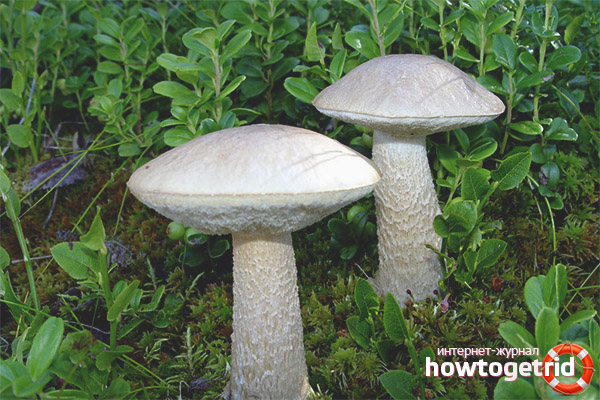The content of the article
White boletus is one of those mushrooms that belong to the department of Basidiomycetes, class Agaricomycetes, the Boletov family, the genus Leccinum. In Latin, the mushroom is called Leccinum holopus. There are also other names for white boletus: swamp boletus, white birch, swamp. This species is completely safe and is suitable for human consumption.
Appearance
The cap circumference of this type of mushroom can vary within certain limits, starting from three and ending with eight centimeters. At a very young age, at the beginning of vision, the shape of the marsh birchbark hats is usually hemispherical, but after a certain period of time they become cushion-shaped, and then generally acquire the open shape of the hats. Until the end of the cap, the white boletus almost never opens. This is the main difference between this species and the common boletus. The hat is whitish in color, most often also with impurities of other color variations. It can also be light gray, beige, with a pink tint.
The circumference of the legs reaches a size of from 0.8 to 1.5 centimeters. The closer to the hat, the leg becomes narrower. The leg is white in color; slightly white scales are present on its entire surface. With the growth of the fungus, they begin to dry out and acquire a darker color. The pulp in the leg is softer than in the common boletus. The base of the leg differs precisely in that it has a bluish tint of the color of the pulp.
When can I find a white boletus
This type of mushroom can be found in the period from mid-summer to mid-autumn. For their ripening, mushrooms usually prefer deciduous or mixed forests. Mostly they have mycorrhiza with birch, hence their name comes from - birch bark. The most favorable conditions for their growth are moisture and dampness, so they have a habit of appearing at the very edges of swamps, because their other name is swamps. The mushroom cannot be called very productive, but it is also not rare.
Taste of white boletus

White boletus, as everyone knows, is a mushroom suitable for human consumption. Various sources often talk about their excessive wateriness and unattractive appearance (in contrast to the common boletus). But professional mushroom pickers can confidently say that they are pretty cute mushrooms with delicate pulp. There is as much water in the mushroom cap as in the usual boletus, but it is distinguished by its special softness.
Similar types of mushrooms
Common boletus can be distinguished from its closest relative by the color of the mushroom cap. In this species, it is always much darker. In another way, this mushroom can also be called birch bark or obabek. The hat is quite large, it can be up to 15 centimeters in size.
The color of the hat varies greatly. It happens, both dark brown and light gray, which is directly dependent on the location of the fungus.The form always changes during the growth process: at first it is hemispherical, upon maturation it becomes pillow-shaped. The pulp is colored white or slightly pink, has the same color on the surface of the entire mushroom. The length of the legs can reach up to 15 centimeters with a circumference of up to three centimeters. It has a cylinder-shaped foot, with a slight extension closer to the bottom. It is painted white with shades of gray and covered with oblong scales in a dark color.
Common brown boletus fruits bear fruit from the beginning of summer until the end of autumn. They grow mainly in deciduous forests and prefer birch groves. There are especially fruitful years in which you can find a very impressive amount of this type of mushroom. In recently grown birch groves, this species is one of the first among the remaining edible mushrooms.
Note! Common boletus can be eaten, however, in older fruits, it is recommended to cut a tubular layer.
White boletus - another porcini mushroom very similar to boletus, differs in the color of the pulp markedly changed at the break point. White boletus or white aspen is a fungus that has a fairly large size. It is also distinguished by the presence of a meaty hat, the circumference of which sometimes reaches 25 centimeters in diameter. The hat is painted white, gray-white or gray. The pulp is strong, acquires a blue or green hue to the bottom, at the fracture it is usually bluish, and sometimes it even reaches a deep black color. The leg is high, the bottom is much thicker than the top. It has a white color, along the entire length, longitudinal or white scales with a brownish tint are necessarily located.
White boletus is also suitable for human consumption, they belong to the list of mushrooms of the second category according to the quality of their taste. Fruits from late summer to early winter, provide mushroom pickers a relatively small period of time for search and collection. Young mushrooms of this species are recommended to be marinated, while older ones will be a good option in order to fry or dry.










Submit